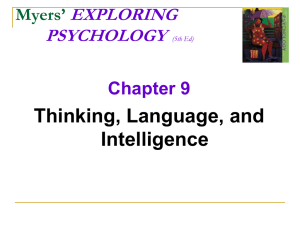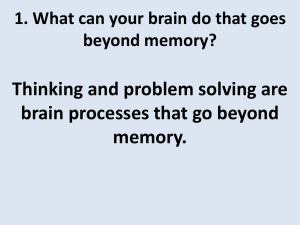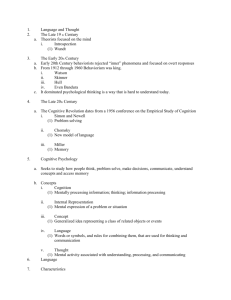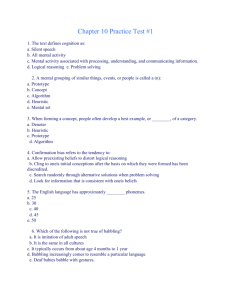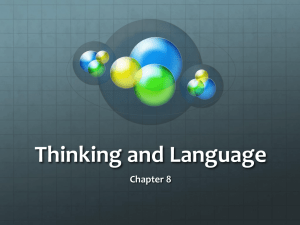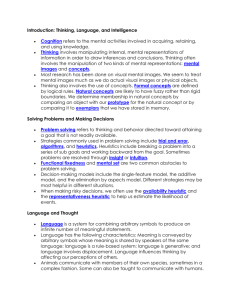Ch. 10
advertisement
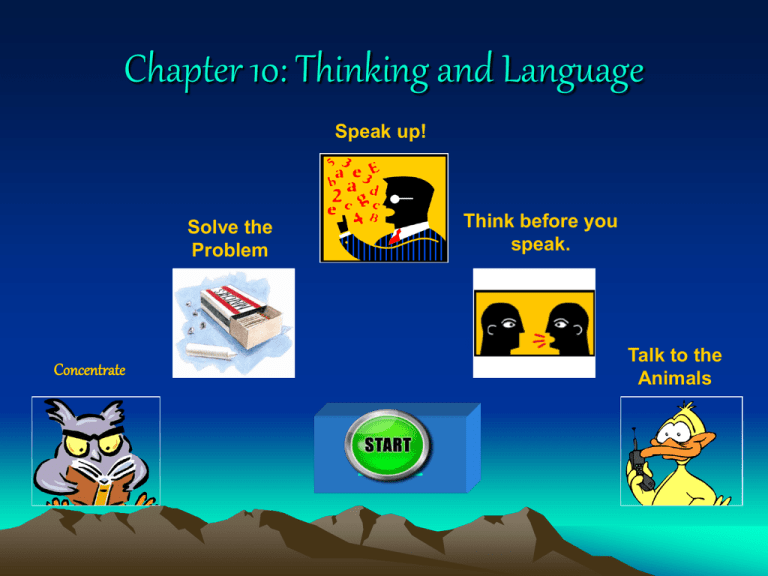
Chapter 10: Thinking and Language Speak up! Think before you speak. Solve the Problem Talk to the Animals Concentrate 100 1. A mental grouping of objects or events is called a: • • • • A) mental image. B) concept. C) abstract representation. D) cognition. 2. When we think of a “bird” we are more likely to think of a robin than a penguin because a robin fits our: • • • • A) perception. B) cognition. C) formal concept. D) prototype. 3. When following this procedure to solve problems, you will always arrive at a correct solution. • • • • A) trial-and-error B) heuristic C) algorithm D) insight 4. Jim misplaced his keys. He knew they were in the house, so he first looked on the hook, then on the dresser, then in other places he has found them in the past. He is using the strategy of: • • • • A) trial-and-error. B) heuristics. C) algorithm. D) insight. 5. A team of researchers have discovered an area of the brain activated during sudden flashes of insight, it was the: • • • • A) right temporal lobe. B) left parietal lobe. C) prefrontal cortex. D) amygdala. 6. When the United States went to war with Iraq on the false assumption it had weapons of mass destruction, this was an example of: • • • • A) heuristics. B) fixation. C) ignorance. D) confirmation bias. 7. Our tendency to approach a problem a certain way, i.e., a way successful in the past, is called: • • • • A) prototype. B) heuristics. C) mental set. D) algorithm. 8. Mary was out of coffee filters. She did not think of using a paper towel, so she went without coffee. Her failure was one of: • • • • A) representativeness heuristic. B) algorithms. C) functional fixedness. D) availability heuristic. 9. Gambling is perpetuated, in part, by the ease we have of remembering the times we won. This is an example of: • • • • A) false memory. B) availability heuristic. C) false prototypes. D) concept misattribution. 10. Politicians know that labeling military action as a “pre-emptive strike” gains more support than, “invasion.” This is an example of: • • • • A) lying. B) framing. C) false advertising. D) political psychobabble. 11. The rules of a language, its ___, helps determine the meaning being communicated. • • • • A) nanogram B) linguistics C) syntax D) morpheme 12. The smallest unit of language that carries meaning is called a: • • • • A) morpheme. B) phoneme. C) babble. D) telegraphic speech. 13. By the time infants are about 10 years old, • A) they should be speaking full sentences. • B) they should be putting two words together. • C) their babbling is universal across all cultures. • D) their babbling has features of the household language. 14. The stage of speech in which a young child says things like, “go car,” and, “momma come,” is called: • • • • A) one-word speech. B) telegraphic speech. C) babbling. D) morpheme speech. 15. Chomsky believes our capacity for language is natural and quick due to: • • • • A) behavioral conditioning. B) sequential developmental stages. C) language being entirely inborn. D) a language acquisition device. 16. According to Worf (1956), differences among languages cause differences in perceptions and thinking. This idea is called: • • • • A) displacement hypothesis. B) linguistic determinism. C) perceptual change theory. D) linguist shift. 17. Deaf children are unable to learn a language: • A) if their parents are hearing and don’t sign. • B) if their parents are deaf and sign. • C) in some languages more than others. • D) regardless of what they are exposed to. 18. Wallace Lambert (1992) found that bilingual education: • A) resulted in a loss in vocabulary for the English speaking children. • B) had no benefit to Canadian students. • C) resulted in higher levels of English proficiency. • D) resulted in higher levels of self-esteem for Hispanics. 19. Thinking without language: • A) is not possible. • B) can improve your performance on the basketball court. • C) is found only in animals. • D) occurs more often in cultures without language. 20. Students wanting to improve their test scores should: • A) should study every chance they get. • B) should spend 5 minutes every day imagining themselves getting an “A”. • C) should think more often. • D) spend 5 minutes every day imagining themselves studying. 21. Most researchers who work with Apes conclude their mental accomplishments: • A) are around the level of a 2-yearold human. • B) include self-recognition. • C) include empathy and reasoning. • D) all of the above. 22. Chimpanzees can use language: • A) to meaningfully communicate with symbols. • B) if taught to speak at an early age. • C) to obey commands. • D) just like people. 23. Bees communicate: • A) in a quick series of buzzing sounds. • B) with their antennae. • C) by a complex dance to tell where the flowers are. • D) all of the above. 24: Human communication differs from animal communication in our use of: • • • • A) vocal sounds. B) syntax. C) phonemes. D) morphemes. 25. Animal researchers have shown that chimpanzees and apes can: • A) communicate with one another. • B) show insight. • C) comprehend the syntax of human speech. • D) all of the above. Stop here, or continue as a review 1. A mental grouping of objects or events is called a: A) mental image. B) concept. C) abstract representation. D) cognition. 396 2. When we think of a “bird” we are more likely to think of a robin than a penguin because a robin fits our: A) perception. B) cognition. C) formal concept. D) prototype. 396 3. When following this procedure to solve problems, you will always arrive at a correct solution. A) trial-and-error B) heuristic C) algorithm D) insight 397 4. Jim misplaced his keys. He knew they were in the house, so he first looked on the hook, then on the dresser, then in other places he has found them in the past. He is using the strategy of: A) trial-and-error. B) heuristics. C) algorithm. D) insight. 398 5. A team of researchers have discovered an area of the brain activated during sudden flashes of insight, it was the: A) right temporal lobe. B) left parietal lobe. C) prefrontal cortex. D) amygdala. 398 6. When the United States went to war with Iraq on the false assumption it had weapons of mass destruction, this was an example of: A) heuristics. B) fixation. C) ignorance. D) confirmation bias. 399 7. Our tendency to approach a problem a certain way, i.e., a way successful in the past, is called: A) prototype. B) heuristics. C) mental set. D) algorithm. 400 8. Mary was out of coffee filters. She did not think of using a paper towel, so she went without coffee. Her failure was one of: A) representativeness heuristic. B) algorithms. C) functional fixedness. D) availability heuristic. 400 9. Gambling is perpetuated, in part, by the ease we have of remembering the times we won. This is an example of: A) false memory. B) availability heuristic. C) false prototypes. D) concept misattribution. 402 10. Politicians know that labeling military action as a “pre-emptive strike” gains more support than, “invasion.” This is an example of: A) lying. B) framing. C) false advertising. D) political psychobabble. 406 11. The rules of a language, its ___, helps determine the meaning being communicated. A) nanogram B) linguistics C) syntax D) morpheme 411 12. The smallest unit of language that carries meaning is called a: A) morpheme. B) phoneme. C) babble. D) telegraphic speech. 411 13. By the time infants are about 10 months old, A) they should be speaking full sentences. B) they should be putting two words together. C) their babbling is universal across all cultures. D) their babbling has features of the household language. 412 14. The stage of speech in which a young child says things like, “go car,” and, “momma come,” is called: A) one-word speech. B) telegraphic speech. C) babbling. D) morpheme speech. 413 15. Chomsky believes our capacity for language is natural and quick because: A) behavioral conditioning. B) sequential developmental stages. C) language being entirely inborn. D) a language acquisition device. 414 16. According to Worf (1956), differences among languages cause differences in perceptions and thinking. This idea is called: A) displacement hypothesis. B) linguistic determinism. C) perceptual change theory. D) linguist shift. 418 17. Deaf children are unable to learn a language: A) if their parents are hearing and don’t sign. B) if their parents are deaf and sign. C) in some languages more than others. D) regardless of what they are exposed to. 414 18. Wallace Lambert (1992) found that bilingual education: A) resulted in a loss in vocabulary for the English speaking children. B) had no benefit to Canadian students. C) resulted in higher levels of English proficiency. D) resulted in higher levels of selfesteem for Hispanics. 420 19. Thinking without language: A) is not possible. B) can improve your performance on the basketball court. C) is found only in animals. D) occurs more often in cultures without language. 421 20. Students wanting to improve their test scores should: A) should study every chance they get. B) should spend 5 minutes every day imagining themselves getting an “A”. C) should think more often. D) spend 5 minutes every day imagining themselves studying. 421 21. Most researchers who work with Apes conclude their mental accomplishments: A) are around the level of a 2-yearold human. B) include self-recognition. C) include empathy and reasoning. D) all of the above. 426 22. Chimpanzees can use language: A) to meaningfully communicate with symbols. B) if taught to speak at an early age. C) to obey commands. D) just like people. 427 23. Bees communicate: A) in a quick series of buzzing sounds. B) with their antennae. C) by a complex dance to tell where the flowers are. D) all of the above. 428 24: Human communication differs from animal communication in our use of: A) vocal sounds. B) syntax. C) phonemes. D) morphemes. 4286 25. Animal researchers have shown that chimpanzees and apes can: A) communicate with one another. B) show insight. C) comprehend the syntax of human speech. D) all of the above. 428 Answers 1. B 9. B 17. A 2. D 10. B 18. C 3. C 11. C 19. B 4. B 12. A 20. D 5. A 13. D 21. D 6. D 14. B 22. A 7. C 15. D 23. C 8. C 16. B 24. B 25. D

